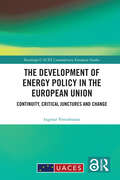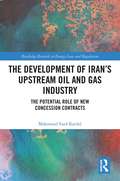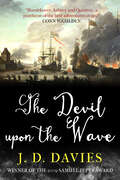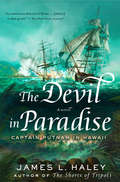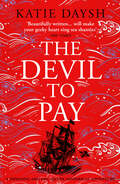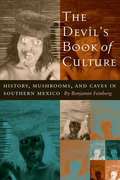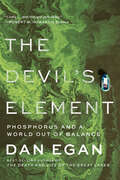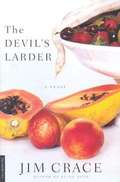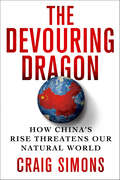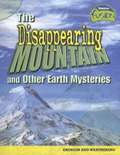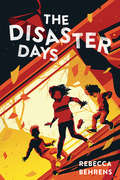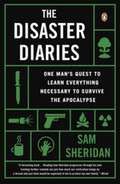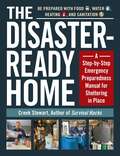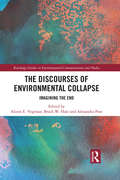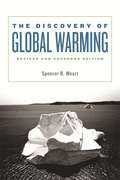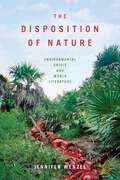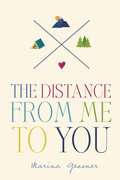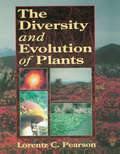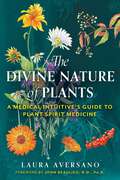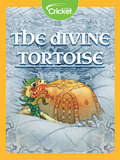- Table View
- List View
The Destruction of the Bison: An Environmental History, 1750-1920
by Andrew C. IsenbergThe Destruction of the Bison explains the decline of the North American bison population from an estimated 30 million in 1800 to fewer than 1000 a century later. In this wide-ranging, interdisciplinary study, Andrew C. Isenberg argues that the cultural and ecological encounter between Native Americans and Euroamericans in the Great Plains was the central cause of the near extinction of the bison. Drought and the incursion of domestic livestock and exotic species such as horses into the Great Plains all threatened the Western ecosystem, which was further destabilized as interactions between Native Americans and Euroamericans created new types of hunters in both cultures: mounted Indian nomads and white commercial hide hunters. In the early twentieth century, nostalgia about the very cultural strife that first threatened the bison became, ironically, an important impetus to its preservation.
The Development of Energy Policy in the European Union: Continuity, Critical Junctures and Change (Routledge/UACES Contemporary European Studies)
by Ingmar VersolmannThis book uniquely details the longer-term integration of energy policy in the EU, from its inception to the contemporary ‘Energy Union’, whilst also bringing it fully up to date regarding its place in current climate discussions, the European Green Deal, REPowerEU, the European Climate Law and the struggle to achieve net zero.Analysing the policy area from a perspective that explains current developments through economic processes, path dependence, and political decisions over time, the book identifies the factors and mechanisms that enable and constrain actors and energy policy development. It contributes to the broader debate about institutional design and (European) integration in the energy sector, examining key legislation, the motives of actors complying with institutional rules, and the idiosyncratic factors that contribute to continuity and account for change.This book will be of key interest to scholars, students and practitioners/policymakers interested in European energy policy and energy/environmental governance, and more broadly to European politics and theories of European integration, international political economy, public policy, international organisations, and global governance.
The Development of Iran’s Upstream Oil and Gas Industry: The Potential Role of New Concession Contracts (Routledge Research in Energy Law and Regulation)
by Mahmoud Fard KardelThis book critically examines different forms of petroleum contracts, the historical perspective of the oil and gas industry and the political economy of the petroleum development in Iran. In doing this, the author provides analysis of the concept of concession in oil and gas development. This is discussed through the main forms of concession contracts; namely, the classic concession contract (CCC) and the new concession contract (NCC). The book ties together much of the existing work on the history of oil and gas regulation in Iran and builds on that foundation to propose a coherent and balanced approach within the framework of the NCC. To consider the role of the NCC in developing national upstream oil and gas industry, comparative examples are drawn from countries currently using, or having previously used, NCC oil and gas contracts. The selected developed and developing countries are Brazil, Thailand, the United Kingdom, Australia and Norway. The analysis considers the extent to which the NCC has served to advance the objectives and national interests of the national governments in this industry. The book involves a comparative exploration of the utilisation of NCCs in other jurisdictions and synthesises a framework through which Iran may develop its underutilised oil and gas resources. Of interest to academics, students and practitioners throughout the world, this book focuses on the relevant aspects of Iran’s Constitution and natural resource laws and makes recommendations for law reform to Iran’s legal frameworks.
The Devil Upon the Wave (The Matthew Quinton Journals)
by J. D. DaviesBroadsides, divided loyalties, and revenge on the high seas—eighth in the Matthew Quinton series from the award-winning author of Death&’s Bright Angel. 1671: Matthew Quinton is on a mission into the heart of enemy waters, bent on revenge for England&’s crushing defeat of 1667. The Dutch not only destroyed English ships and slaughtered their men, but stole the jewel of the fleet, the flagship Royal Charles. As the mission starts to unravel, Quinton is faced with a dilemma. He may need to sail into battle not with his men, but on an enemy man-of-war, against his own side . . . Fans of Julian Stockwin and John Drake will love The Devil Upon the Wave, book eight in the Matthew Quinton Journals. Praise for the series &“Hornblower, Aubrey and Quinton—a pantheon of the best adventures at sea!&” —Conn Iggulden, #1 New York Times–bestselling author &“Finely shaded characters, excellent plotting, gut-clenching action and immaculate attention to period naval detail . . . These are superb books.&” —Angus Donald, author of The Outlaw Chronicles &“A splendid addition to nautical adventure, and a grand story, to boot!&” —Dewey Lambdin, author of the Alan Lewrie Naval Adventures
The Devil in Paradise: Captain Putnam in Hawaii (A Bliven Putnam Naval Adventure #3)
by James L. HaleyCaptain Bliven Putnam returns, venturing into the Pacific to fight pirates in Malaya and match wits with the royals in Hawaii, in this next installment of award-winner James L. Haley's gripping naval saga.Following the naval victories of the War of 1812 and the Second Barbary War, the United States is finally expanding its navy to take a place of prominence in world affairs. Bliven Putnam, now Captain of the sloop of war Rappahannock, has come into his own as a leader and is ordered to the Pacific. But with this new tour of duty to last more than two years, his patient wife, Clarity, unwilling to accept such a brief time together, at last puts her foot down. If she can't keep Putnam with her, then she'll just have to go with him.As Putnam sets sail for his new home port in Honolulu, Clarity joins a new missionary effort from Boston to Hawaii. On their respective paths, the Putnams encounter a new breed of pirate and meet an unexpected force of nature: Kahumanu, the formidable queen of the Hawaiian Islands. Inspried by the real-life Olowalu Massacre and the famed Congregationalist missoin of 1819, this third outing will be unlike any adventure the Putnams have faced before.
The Devil to Pay: A sweeping and epic queer historical adventure (Nightingale & Courtney)
by Katie DayshIn a world of gunpowder, smoke and blood, two men’s love will rise above the chaos. 'An absorbing follow-up to the brilliant Leeward' The Times In 1802, The Treaty of Amiens brings the French Revolutionary Wars to an end. After the drama of the past few years, Lieutenant Arthur Courtney returns home to England where he hopes to spend a blissful summer with his close friend, Hiram Nightingale. But within weeks, HMS Loyal goes missing en route to Malta. She carries a French and British diplomat, Hugo Baptiste and Sir William Haywood. Their disappearance, in this tentative time of peace, may be enough to prematurely ignite war between France and Britain once more. Both Courtney and Nightingale, Sir William’s son-in-law, receive a position on HMS Lysander, tasked with tracking down the missing frigate. But as their mission grows ever more dangerous with each passing day, the risk of dissension simmers menacingly on the deck of the Lysander. And when painful memories finally begin to rise to the surface after so many years, the truth of Courtney and Nightingale’s powerful bond could be the spark that sets everything ablaze… A thrilling queer adventure on the High Seas, with romance, naval warfare and long hidden secrets finally come to light. Perfect for fans of Kate Mosse, Ken Follett and Diana Gabaldon.
The Devil's Book of Culture: History, Mushrooms, and Caves in Southern Mexico
by Benjamin FeinbergSince the 1950s, the Sierra Mazateca of Oaxaca, Mexico, has drawn a strange assortment of visitors and pilgrims—schoolteachers and government workers, North American and European spelunkers exploring the region's vast cave system, and counterculturalists from hippies (John Lennon and other celebrities supposedly among them) to New Age seekers, all chasing a firsthand experience of transcendence and otherness through the ingestion of psychedelic mushrooms "in context" with a Mazatec shaman. Over time, this steady incursion of the outside world has significantly influenced the Mazatec sense of identity, giving rise to an ongoing discourse about what it means to be "us" and "them." In this highly original ethnography, Benjamin Feinberg investigates how different understandings of Mazatec identity and culture emerge through talk that circulates within and among various groups, including Mazatec-speaking businessmen, curers, peasants, intellectuals, anthropologists, bureaucrats, cavers, and mushroom-seeking tourists. Specifically, he traces how these groups express their sense of culture and identity through narratives about three nearby yet strange discursive "worlds"—the "magic world" of psychedelic mushrooms and shamanic practices, the underground world of caves and its associated folklore of supernatural beings and magical wealth, and the world of the past or the past/present relationship. Feinberg's research refutes the notion of a static Mazatec identity now changed by contact with the outside world, showing instead that identity forms at the intersection of multiple transnational discourses.
The Devil's Element: Phosphorus And A World Out Of Balance
by Dan EganA New Yorker Best Book of the Year "Lively…and thought-provoking.” —Robert W. Howarth, Science The New York Times best-selling author on the source of great bounty—and now great peril—all over the world. Phosphorus has played a critical role in some of the most lethal substances on earth: firebombs, rat poison, nerve gas. But it’s also the key component of one of the most vital: fertilizer, which has sustained life for billions of people. In this major work of explanatory science and environmental journalism, Pulitzer Prize finalist Dan Egan investigates the past, present, and future of what has been called “the oil of our time.” The story of phosphorus spans the globe and vast tracts of human history. First discovered in a seventeenth-century alchemy lab in Hamburg, it soon became a highly sought-after resource. The race to mine phosphorus took people from the battlefields of Waterloo, which were looted for the bones of fallen soldiers, to the fabled guano islands off Peru, the Bone Valley of Florida, and the sand dunes of the Western Sahara. Over the past century, phosphorus has made farming vastly more productive, feeding the enormous increase in the human population. Yet, as Egan harrowingly reports, our overreliance on this vital crop nutrient is today causing toxic algae blooms and “dead zones” in waterways from the coasts of Florida to the Mississippi River basin to the Great Lakes and beyond. Egan also explores the alarming reality that diminishing access to phosphorus poses a threat to the food system worldwide—which risks rising conflict and even war. With The Devil’s Element, Egan has written an essential and eye-opening account that urges us to pay attention to one of the most perilous but little-known environmental issues of our time.
The Devouring Dragon: How China's Rise Threatens Our Natural World
by Craig SimonsChina's rise is assaulting the natural world at an alarming rate. In a few short years, China has become the planet's largest market for endangered wildlife, its top importer of tropical trees, and its biggest emitter of greenhouse gases. Its rapid economic growth has driven up the world's very metabolism: in Brazil, farmers clear large swaths of the Amazon to plant soybeans; Indian poachers hunt tigers and elephants to feed Chinese demand; in the United States, clouds of mercury and ozone drift earthward after trans-Pacific jet-stream journeys. Craig Simons' The Devouring Dragon looks at how an ascending China has rapidly surpassed the U.S. and Europe as the planet's worst-polluting superpower. It argues that China's most important 21st-century legacy will be determined not by jobs, corporate profits, or political alliances, but by how quickly its growth degrades the global environment and whether it can stem the damage. Combining in-depth reporting with wide-ranging interviews and scientific research, The Devouring Dragon shines a spotlight on how China has put our planet's forests, wildlife, oceans, and climate in jeopardy, multiplying the risks for everyone in our burgeoning, increasingly busy world.
The Dimensions of Federalism: State Governments and Pollution Control Policies
by William R. LowryThe resurgence of state involvement in policymaking in recent years has renewed a long-standing debate about the most effective role for states within a federal system of government. In The Dimensions of Federalism, William R. Lowry assesses and examines the responsiveness and innovation of state governments in the area of air and water pollution control policies. Building a theoretical model that demonstrates the relationship between state and federal governments, Lowry combines econometric analysis of data on all fifty states with an in-depth study of a leading state in each of four major areas of pollution policy to conclude that state policymakers will often experiment and willingly improve upon federal pollution control standards. But this willingness is tempered, he maintains, both by a fear of losing important constituents to interstate competition and by the difficulty of coordinating efforts and disseminating information without the active involvement of the federal government. Originally published in 1992, this book continues to be pertinent in a political climate that will inevitably see an increased role for states in domestic policymaking. It will be of great interest to students and scholars of American public policy, federalism, and environmental politics and policy.
The Disappearing Mountain and Other Earth Mysteries: Erosion and Weathering (Raintree Fusion: Earth Science)
by Louise Spilsbury Richard SpilsburyThe Earth's surface is changing all the time. In the past, people made up stories to explain these mysteries. Your mission is to find out the facts.
The Disaster Days
by Rebecca BehrensHatchet meets The Babysitters Club in this epic and thrilling survival story about pushing oneself to the limit in the face of a crisis.We were all alone, in a shaken and shattered house, in the dark. And I was in charge.Hannah Steele loves living on Pelling, a tiny island near Seattle. She's always felt totally safe there.So when she's asked to babysit after school one day, it's no big deal. Zoe and Oscar are her next-door neighbors, and Hannah just took a babysitting class, which she's pretty sure makes her an expert. She isn't even worried that she left her inhaler at home.Then the shaking begins.The terrifying earthquake only lasts four minutes, but it changes everything—damaging the house, knocking out the power, and making cell service nonexistent. Even worse, the ferry and the bridge connecting the kids to help—and their parents—are both blocked, which means they're stranded alone. And Hannah's in charge as things go from bad to worse.Praise for The Disaster Days:"A realistic, engrossing survival story that's perfect for aspiring babysitters and fans of John Macfarlane's Stormstruck!, Sherry Shahan's Ice Island, or Wesley King's A World Below."—School Library Journal"The strength of this steadily paced novel that stretches over four days of a scary disaster scenario is that Hannah doesn't figure everything out; she stumbles, doubts, and struggles throughout it all."—The Bulletin of the Center for Children's Books"Fans of survival thrillers in the vein of Gary Paulsen's Hatchet will enjoy this tense, honest tale of bravery...an excellent (and refreshingly not didactic) teaching tool on natural-disaster preparedness."—Booklist"The relentless progression of a variety of disaster scenarios will keep readers turning pages…equally suspenseful and informative."—School Library Connection"Behrens uses immersive details and situations effectively viewed from Hannah's perspective to create a suspenseful, vivid story filled with lessons about responsibility and overcoming adversity."—Publishers WeeklyThe Disaster Days is a perfect…gift for preteen survival story fansearthquake fiction chapter book for tween girls ages 11-14survivalist fiction book for middle grade girlssummer reading book for preteenspreteen gift for girls
The Disaster Diaries
by Sam SheridanSam Sheridan has traveled the world as an amateur boxer and mixed martial arts fighter; he has worked as an EMT, a wilderness firefighter, a sailor, a cowboy at the largest ranch in Montana, and in construction under brutal conditions at the South Pole. If he isn't ready for the Apocalypse and the fractured world that will likely ensue, we are all in a lot of trouble. Despite an arsenal of skills that puts many to shame, when Sam became a father he was beset with nightmares about being unable to protect his son. With disaster images from movies, books, and the nightly news filling his head, he was slowly being driven to distraction. If a rogue wave hit his beach community, would he be able to get out? If the power grid went down and he was forced outside the city limits, could he survive in the wilderness? And let's not even talk about plagues, zombie hoards, and attacking aliens. Unable to quiet his mind, Sam decides to face his fears head-on and gain as many skills as possible. The problem is each doomsday situation requires something unique. Trying to navigate the clogged highway out of town? Head to the best stunt driving school in the country. Need to protect your family, but out of ammunition? Learn how to handle a knife. Is your kid hurt or showing signs of mental strain? Better brush upon emergency medicine and the psychological effects of trauma. From training with an Olympic weight lifter to a down and dirty apprenticeship in stealing cars with an ex-gang member, from a gun course in the hundred-degree heat of Alabama to agonizing lessons in arctic wilderness survival, Sam leaves no stone unturned. Will it be enough if a meteor rocks the earth? Who's to say? But as Sam points out, it would be a damn shame to survive the initial impact only to die a few days later because you don’t know how to build a fire. A rollicking narrative with each chapter framed by a hypothetical catastrophic scenario, The Disaster Diaries is irresistible armchair adventure reading for everyone curious about what it might take to survive a cataclysmic event and those who just want to watch someone else struggling to find out. .
The Disaster Preparedness Handbook: A Guide for Families
by Arthur T. BradleyNinety-nine percent of the time, the world spins like a top, the skies are clear, and your refrigerator is full of good food. But the world is a volatile place—storms rage, fires burn, and diseases spread. No one is ever completely safe. Humans live as part of a very complex ecosystem that is unpredictable and merciless. Could you protect your family in the case of an emergency—domestic or global?The Disaster Preparedness Handbook will help you to establish a practical disaster plan for your entire family (covering all fourteen basic human needs) in case the unpredictable happens. Additional information is also presented for those with special needs, including the elderly and disabled, children, pregnant women, and even pets. Well-researched by an army veteran and current NASA engineer, this is the essential guide every family should have, study, and keep handy, in case the unthinkable should occur.
The Disaster-Ready Home: A Step-by-Step Emergency Preparedness Manual for Sheltering in Place
by Creek StewartA complete, step-by-step manual for safely sheltering-in-place at home so you are prepared for any disaster or disease.If a disaster forces you to shelter in place, do you think you have everything you need to safely and comfortably stay put in your home? If the answer is no, The Disaster-Ready Home will help you create a safe, well-stocked place to weather out any emergency. Survival expert and bestselling author Creek Stewart gives you a step-by-step emergency preparedness plan to meet your food, water, heat, and sanitation needs during any disaster. Including detailed lists, photographs, and complete instructions to make the plan easy to follow, this book is the only resource you need for a disaster. You&’ll learn how to: -Create an emergency pantry stocked with enough food for the timeframe of your choice—from two weeks to three months to a full year -Select and store food that fits your taste, diet, and budget -Easily rotate and use your emergency food supply, so nothing goes to waste -Set up long-term water storage and renewable water sources -Cook food and boil water when your kitchen appliances aren&’t working -Safely heat and light your home when the power is out -Effectively manage sanitation issues if running water is unavailable -And much more! With daily headlines dominated by disease and disasters, the need to be prepared has never been more evident. This practical, field-tested guide will help you protect and provide for your family when any situation arises.
The Discourses of Environmental Collapse: Imagining the End (Routledge Studies in Environmental Communication and Media)
by Alexandra Peat Alison E. Vogelaar Brack W. HaleIn recent years, ‘environmental collapse’ has become an important way of framing and imagining environmental change and destruction, referencing issues such as climate change, species extinction and deteriorating ecosystems. Given its pervasiveness across disciplines and spheres, this edited volume articulates environmental collapse as a discursive phenomenon worthy of sustained critical attention. Building upon contemporary conversations in the fields of archaeology and the natural sciences, this volume coalesces, explores and critically evaluates the diverse array of literatures and imaginaries that constitute environmental collapse. The volume is divided into three sections— Doc- Collapse, Pop Collapse and Craft Collapse —that independently explore distinct modes of representing, and implicit attitudes toward, environmental collapse from the lenses of diverse fields of study including climate science and policy, cinema and photo journalism. Bringing together a broad range of topics and authors, this volume will be of great interest to scholars of environmental communication and environmental humanities.
The Discovery Of Global Warming: New Histories of Science, Technology, and Medicine
by Spencer R. WeartThe award-winning book is now revised and expanded. In 2001 an international panel of distinguished climate scientists announced that the world was warming at a rate without precedent during at least the last ten millennia, and that warming was caused by the buildup of greenhouse gases from human activity. The story of how scientists reached that conclusion-by way of unexpected twists and turns-was the story Spencer Weart told in The Discovery of Global Warming. Now he brings his award-winning account up to date, revised throughout to reflect the latest science and with a new conclusion that shows how the scientific consensus caught fire among the general world public, and how a new understanding of the human meaning of climate change spurred individuals and governments to action.
The Discovery of Global Warming: Revised and Expanded Edition (New histories of science, technology, and medicine #13)
by Spencer R. WeartThe award-winning book is now revised and expanded. In 2001 an international panel of distinguished climate scientists announced that the world was warming at a rate without precedent during at least the last ten millennia, and that warming was caused by the buildup of greenhouse gases from human activity. The story of how scientists reached that conclusion—by way of unexpected twists and turns—was the story Spencer Weart told in The Discovery of Global Warming. Now he brings his award-winning account up to date, revised throughout to reflect the latest science and with a new conclusion that shows how the scientific consensus caught fire among the general world public, and how a new understanding of the human meaning of climate change spurred individuals and governments to action.
The Disposition of Nature: Environmental Crisis and World Literature
by Jennifer WenzelFinalist, 2022 Ecocriticism Book Prize, Association for the Study of Literature and the EnvironmentShortlisted, 2020 Book Prize, Association for the Study of the Arts of the PresentHow do literature and other cultural forms shape how we imagine the planet, for better or worse? In this rich, original, and long awaited book, Jennifer Wenzel tackles the formal innovations, rhetorical appeals, and sociological imbrications of world literature that might help us confront unevenly distributed environmental crises, including global warming.The Disposition of Nature argues that assumptions about what nature is are at stake in conflicts over how it is inhabited or used. Both environmental discourse and world literature scholarship tend to confuse parts and wholes. Working with writing and film from Africa, South Asia, and beyond, Wenzel takes a contrapuntal approach to sites and subjects dispersed across space and time. Reading for the planet, Wenzel shows, means reading from near to there: across experiential divides, between specific sites, at more than one scale.Impressive in its disciplinary breadth, Wenzel’s book fuses insights from political ecology, geography, anthropology, history, and law, while drawing on active debates between postcolonial theory and world literature, as well as scholarship on the Anthropocene and the material turn. In doing so, the book shows the importance of the literary to environmental thought and practice, elaborating how a supple understanding of cultural imagination and narrative logics can foster more robust accounts of global inequality and energize movements for justice and livable futures.
The Distance from Me to You
by Marina GessnerWild meets Endless Love in this multilayered story of love, survival, and self-discoveryMcKenna Berney is a lucky girl. She has a loving family and has been accepted to college for the fall. But McKenna has a different goal in mind: much to the chagrin of her parents, she defers her college acceptance to hike the Appalachian Trail from Maine to Georgia with her best friend. And when her friend backs out, McKenna is determined to go through with the dangerous trip on her own. While on the Trail, she meets Sam. Having skipped out on an abusive dad and quit school, Sam has found a brief respite on the Trail, where everyone's a drifter, at least temporarily.Despite lives headed in opposite directions, McKenna and Sam fall in love on an emotionally charged journey of dizzying highs and devastating lows. When their punch-drunk love leads them off the trail, McKenna has to persevere in a way she never thought possible to beat the odds or risk both their lives.
The Diversity Of Life
by Edward O. WilsonView a collection of videos on Professor Wilson entitled "On the Relation of Science and the Humanities" "In the Amazon Basin the greatest violence sometimes begins as a flicker of light beyond the horizon. There in the perfect bowl of the night sky, untouched by light from any human source, a thunderstorm sends its premonitory signal and begins a slow journey to the observer, who thinks: the world is about to change. " Watching from the edge of the Brazilian rain forest, witness to the sort of violence nature visits upon its creatures, Edward O. Wilson reflects on the crucible of evolution, and so begins his remarkable account of how the living world became diverse and how humans are destroying that diversity. Wilson, internationally regarded as the dean of biodiversity studies, conducts us on a tour through time, traces the processes that create new species in bursts of adaptive radiation, and points out the cataclysmic events that have disrupted evolution and diminished global diversity over the past 600 million years. The five enormous natural blows to the planet (such as meteorite strikes and climatic changes) required 10 to 100 million years of evolutionary repair. The sixth great spasm of extinction on earth--caused this time entirely by humans--may be the one that breaks the crucible of life. Wilson identifies this crisis in countless ecosystems around the globe: coral reefs, grasslands, rain forests, and other natural habitats. Drawing on a variety of examples such as the decline of bird populations in the United States, the extinction of many species of freshwater fish in Africa and Asia, and the rapid disappearance of flora and fauna as the rain forests are cut down, he poignantly describes the death throes of the living world's diversity--projected to decline as much as 20 percent by the year 2020. All evidence marshaled here resonates through Wilson's tightly reasoned call for a spirit of stewardship over the world's biological wealth. He makes a plea for specific actions that will enhance rather than diminish not just diversity but the quality of life on earth. Cutting through the tangle of environmental issues that often obscure the real concern, Wilson maintains that the era of confrontation between forces for the preservation of nature and those for economic development is over; he convincingly drives home the point that both aims can, and must, be integrated. Unparalleled in its range and depth, Wilson's masterwork is essential reading for those who care about preserving the world biological variety and ensuring our planet's health.
The Diversity and Evolution of Plants
by Lorentz C. PearsonThis exciting new textbook examines the concepts of evolution as the underlying cause of the rich diversity of life on earth-and our danger of losing that rich diversity. Written as a college textbook, The Diversity and Evolution of Plants introduces the great variety of life during past ages, manifested by the fossil record, using a new natural classification system. It begins in the Proterozoic Era, when bacteria and bluegreen algae first appeared, and continues through the explosions of new marine forms in the Helikian and Hadrynian Periods, land plants in the Devonian, and flowering plants in the Cretaceous. Following an introduction, the three subkingdoms of plants are discussed. Each chapter covers one of the eleven divisions of plants and begins with an interesting vignette of a plant typical of that division. A section on each of the classes within the division follows. Each section describes where the groups of plants are found and their distinguishing features. Discussions in each section include phylogeny and classification, general morphology, and physiology, ecological significance, economic uses, and potential for research. Suggested readings and student exercises are found at the end of each chapter.
The Divine Nature of Plants: A Medical Intuitive's Guide to Plant Spirit Medicine
by Laura Aversano• Presents the spiritual, emotional, and physical healing properties of 30 common plants and their spirits• Explains how to intuitively, energetically, and spiritually connect with plant spirits and their healing medicine• Shares the author&’s personal story of awakening to the divine powers of plant spiritsSharing her personal story of awakening to the divine powers of plant spirits, medical intuitive Laura Aversano takes you on a journey deep into sacred connection with the elemental world of nature where plants are animated intelligent beings.Aversano explains how to intuitively, energetically, and spiritually connect with plant spirits and their healing medicine, including how to make your own plant spirit essences. She presents the stories and remedies of 30 common plants—including Astragalus, Black Cohosh, Lilac, Motherwort, and Violet—whose spirits she has worked with for years to nurture herself and her friends, family, and clients. She shares her inner experience with each plant, including visitations from the fairy, deva, or spirit that endows and protects each plant. For each plant she includes a plant spirit prayer and explores the plant&’s spiritual, emotional, and physical healing properties.Revealing that each plant has a divine purpose to help us heal, Aversano shows how we each have the power to come into divine relationship with the plant kingdom to heal ourselves and our loved ones.
The Divine Tortoise
by Quen LawA boy named Ty is sent on several impossible errands by his scheming stepmother and each time he is helped by a tortoise. Frustrated by his success, Ty’s stepmother sends him away. Ty decides to follow the river looking for work when he encounters the emperor making a sacrifice to the river god. Can Ty help the emperor?

